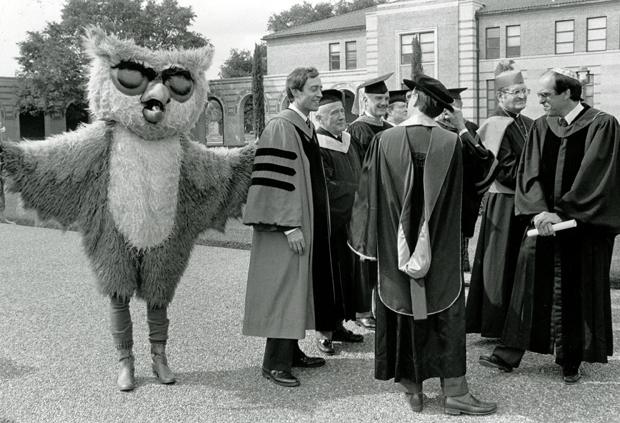At almost 100 years old, one of Rice’s best-known characters has had quite an existence. He’s been kidnapped (multiple times), shot at and smuggled out of a hotel disguised as a corpse. He’s even died — multiple times. He’s never uttered a word, yet his enthusiasm for Rice is full-volume. He’s Sammy the Owl, Rice’s beloved mascot.
The story of Sammy begins with Edgar Odell Lovett — “Every story starts with Dr. Lovett,” said Rice Historian Melissa Kean ’96, who, along with Karen Hess Rogers ’68, recently gave a brown-bag talk about the history of Sammy.
At the institute’s founding, Lovett had Rice’s academic seal designed, and it incorporated owls, which have long symbolized wisdom and learning. (Rogers amusingly noted that decades later, researchers determined that owls are among the dimmest of birds — “They are even dumber than chickens, if that’s possible,” she said.)
Students adopted the owl as Rice’s mascot, although it was unnamed until an event in 1917.

The Rice Institute football team of 1916 poses with a live owl (front row). "The owl looks none too happy," observed Rice Historian Melissa Kean. From Rice University, http://hdl.handle.net/1911/63836.
Students had created a 6-foot-tall, 191-pound canvas owl stuffed with wood shavings that they took to athletic events. After a Rice basketball victory over Texas A&M in 1917, several Aggies kidnapped the mascot and sent a message: “If Rice wishes to claim their bird and ever think they are able to take him back to the ‘Institoot,’ they can find him at 37 Milner Hall, College Station, Texas.”

The "kidnapped" Rice Owl mascot surrounded by Texas A&M students in 1917. From Rice University, http://hdl.handle.net/1911/71149
A group of Rice students calling themselves the Owl Protective Association hired a private detective to find the missing bird. The detective located the mascot in College Station and sent the students a coded telegram: “Sammy is better and would like to see his parents at 11 o’clock.”
Upon receipt of the telegram, 17 Rice men raced to College Station to rescue the mascot from the U.S. Armory, where a night watchman fired his pistol at them.
“Awakened by the gunshots, A&M students gave chase,” Rogers said, and at one point, several hundred Aggies were searching for the Rice men in the countryside around College Station. They captured nine of the Rice students.
The remaining eight, whose evasive actions were surely hindered by the unwieldiness of the massive bird, opted to cut the canvas skin off it and burn the wood-shaving stuffing. “Attracted by the smoke, a party of cadets captured four more Rice men,” Rogers said. “The last four were rescued by hunters; they and ‘Sammy’ returned to Houston. Thirteen Rice men remained imprisoned at A&M until Rice President Edgar Odell Lovett petitioned the A&M president for their return.”

A photograph marked "The Party that invaded A&M of Texas and retook the stolen Rice Owl" shows a group of men holding the canvas skin of the newly named "Sammy." From Rice University, http://hdl.handle.net/1911/71174.
While the name “Sammy” stuck for the mascot, the presence of the bird on campus did not. It was eight years before Sammy would reappear as a fixture at sports events, pep rallies and more in an inanimate form that varied over the years. He remained, however, the target of abduction.
In 1935, during a football game against Southern Methodist University, a group of SMU freshmen attempted to steal Sammy; members of the Rice band intervened to save the mascot.

Students pose with a stuffed, painted Sammy the Owl in 1934. From Rice University, http://hdl.handle.net/1911/64080.
In 1943, the Aggies nabbed Sammy yet again. According to Rogers, they took him to the Rice Hotel in downtown Houston, where they checked the giant owl in at the checkroom and then posted guards around the hotel. Fortunately for the university, the manager of the hotel was “a friend of the Owls,” and he helped the Rice students slip Sammy out of the hotel right under the Aggies’ noses. He contacted a local funeral home, which sent an ambulance to the hotel. “They wrapped Sammy in white sheets to resemble a corpse, and he was carried out on a stretcher and returned to Rice,” she said.
In the 1950s, Sammy began appearing in cartoon form on the front of football programs. “The 1950s, in my mind, is sort of the golden age of Sammy,” Kean said.

Three programs from Rice football games during the so-called powerhouse years of the program. From Melissa Kean, http://ricehistorycorner.files.wordpress.com.
By the mid-1960s, most of the Southwest Conference schools had live animal mascots, Rogers said, so students acquired a live Great Horned Owl for Rice. In fact, over the next 30 years there were many live Sammys, some of which met with most unfortunate ends.

A Rice Thresher article Oct. 28, 1965, reported the death of one of the live Sammy mascots. From Rice University, http://hdl.handle.net/1911/44695.

An article in the Dec. 9, 1965, Rice Thresher reports Sammy II's death. From Rice University, http://hdl.handle.net/1911/48432.
Rice abandoned live mascots by the mid-1990s in favor of a student dressed in an owl costume, which had begun appearing along with the live owls in the 1970s.

Two live owl mascots pose with a costumed Sammy in 1989. From Rice University, http://hdl.handle.net/1911/76199.
This most recent incarnation of Sammy has been rousing fans, making mischief and witnessing Rice history for more than 40 years. In an ever-evolving costume, he celebrated the inauguration of President George Rupp (1986), been elected homecoming queen (1995) and jumped on the dog pile after Rice’s 2003 College World Series victory. The most recent incarnation of Sammy debuted in 2012, just in time to celebrate the university’s centennial.

Sammy the Owl at President George Rupp's inauguration in 1986. From Melissa Kean, http://ricehistorycorner.files.wordpress.com.




Leave a Reply